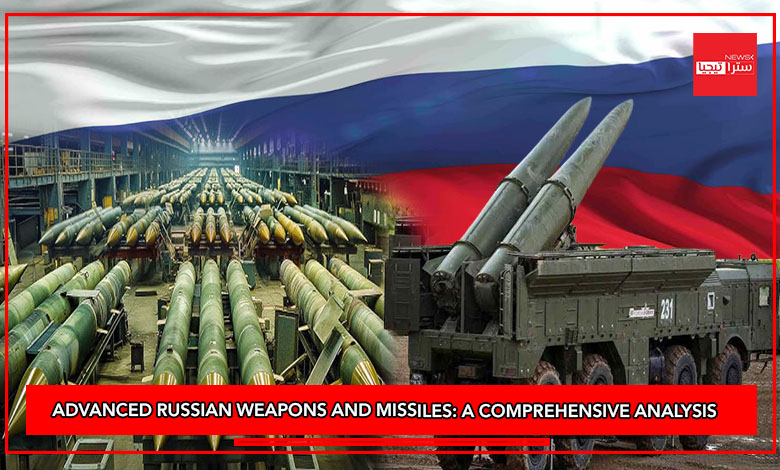Department of Strategic Security and Military Research and Studies 26-11-2024
Russia has consistently advanced its military capabilities, developing sophisticated weapons systems designed to maintain strategic parity or superiority on the global stage. With tensions rising in various geopolitical hotspots, Russia’s advanced weapons and missile systems are pivotal to its military doctrine, ensuring readiness in the event of conflict. This study explores Russia’s key weapons innovations, their potential applications, and examples of their strategic significance.
1. Hypersonic Weapons: Redefining Speed and Precision
Hypersonic weapons represent a cornerstone of Russia’s advanced military arsenal. These missiles travel at speeds exceeding Mach 5, rendering conventional defense systems largely ineffective due to their speed, maneuverability, and low-altitude flight paths.
Key Systems:
Avangard Hypersonic Glide Vehicle (HGV):
Deployed as part of Russia’s strategic nuclear forces, Avangard can travel at speeds up to Mach 27 and maneuver unpredictably to evade missile defense systems. It is launched atop an intercontinental ballistic missile (ICBM), such as the UR-100N, and descends onto its target with devastating accuracy.
Example: The deployment of Avangard in 2019 marked a new era of deterrence, with Russian officials claiming it can penetrate any existing missile defense system.
Kinzhal (Dagger) Hypersonic Missile:
Air-launched from MiG-31K fighter jets, Kinzhal can strike targets over 2,000 kilometers away. It can carry nuclear or conventional warheads, making it a versatile weapon for both strategic and tactical missions.
Example: Russia has tested Kinzhal in simulated combat scenarios to target hardened military bunkers and critical infrastructure.
2. Intercontinental Ballistic Missiles (ICBMs): Modernized Strategic Deterrence
Russia maintains one of the most extensive and modernized ICBM arsenals in the world. These missiles form the backbone of its nuclear triad.
Key Systems:
RS-28 Sarmat (Satan II):
A heavy ICBM designed to replace the aging R-36M Voyevoda, the RS-28 Sarmat boasts a range of over 18,000 kilometers and can carry up to 15 nuclear warheads. It is equipped with countermeasures to bypass missile defenses.
Example: Nicknamed “Satan II,” this missile has the capacity to devastate an area the size of France, highlighting its role in strategic deterrence.
RS-24 Yars:
A road-mobile and silo-based ICBM capable of carrying multiple independently targetable reentry vehicles (MIRVs). Its mobility makes it difficult to locate and neutralize.
Example: Regular drills involving RS-24 Yars demonstrate Russia’s preparedness to deploy these weapons rapidly in case of conflict.
3. Cruise Missiles: Versatility and Range
Russian cruise missiles are designed to engage a wide range of targets with precision. Their ability to evade radar systems by flying at low altitudes and through complex trajectories enhances their effectiveness.
Key Systems:
Kalibr (3M-14):
Known for its precision, the Kalibr missile can strike targets at ranges up to 2,500 kilometers. It is deployable from ships, submarines, and aircraft.
Example: Kalibr missiles were used during Russia’s intervention in Syria, successfully striking militant strongholds from ships stationed in the Caspian Sea.
Kh-101 and Kh-102:
These air-launched cruise missiles are designed for strategic bombers like the Tu-160 and Tu-95. The Kh-101 carries conventional warheads, while the Kh-102 is nuclear-capable.
Example: These missiles have been showcased in precision strikes against targets in Ukraine, emphasizing their long-range capabilities.
4. Anti-Ship Missiles: Maritime Superiority
Anti-ship missile systems ensure Russia’s dominance in naval warfare, capable of neutralizing high-value targets like aircraft carriers.
Key Systems:
P-800 Oniks:
A supersonic cruise missile designed for both land-based and naval platforms. It can strike ships or land targets with precision at ranges of up to 600 kilometers.
Example: Oniks missiles have been deployed in coastal defense batteries in the Arctic and the Black Sea.
3M22 Zircon:
A hypersonic anti-ship missile capable of traveling at Mach 9. Zircon is primarily designed to target naval assets but is also effective against land targets.
Example: Tests conducted in 2022 demonstrated Zircon’s ability to strike moving naval targets, showcasing its advanced guidance systems.
5. Air Defense Systems: Shielding Russian Territory
Russia’s air defense systems are among the most advanced globally, capable of intercepting a wide range of threats, including missiles and aircraft.
Key Systems:
S-400 Triumph:
Known for its versatility, the S-400 can engage targets at distances up to 400 kilometers. It can track and destroy ballistic missiles, cruise missiles, and aircraft.
Example: Deployed in regions like Kaliningrad and Crimea, the S-400 system is critical for protecting Russia’s strategic installations.
S-500 Prometey:
An upgrade to the S-400, the S-500 is designed to intercept hypersonic missiles and low-Earth-orbit satellites.
Example: Scheduled for deployment in 2025, the S-500 represents Russia’s future in integrated air and missile defense.
6. Tactical and Battlefield Systems: Enhancing Ground Forces
In addition to strategic weapons, Russia has developed advanced tactical systems to support its ground forces in potential conflicts.
Key Systems:
Iskander-M:
A short-range ballistic missile system capable of precision strikes against enemy positions up to 500 kilometers away.
Example: Used extensively during the conflict in Ukraine to target military command centers and supply lines.
TOS-1A Thermobaric Rocket Launcher:
A heavy flamethrower system that uses thermobaric warheads to create devastating blast effects.
Example: Deployed in Syria to neutralize entrenched militant positions.
Conclusion
Russia’s advanced weaponry highlights its focus on maintaining military supremacy through cutting-edge technology and strategic innovation. These systems, from hypersonic missiles to sophisticated air defense platforms, ensure Russia’s ability to project power and deter adversaries. However, their deployment in a potential conflict would have catastrophic implications, underlining the urgent need for global diplomacy and arms control agreements to prevent escalation.

